Key takeaways:
- Narrative voice is crucial for enhancing character depth and emotional engagement, influencing how readers connect with the story.
- Experimenting with different types of narrative voices (first-person, third-person, second-person) can transform storytelling and reveal new insights.
- Balancing voice with character is vital; the voice must reflect a character’s internal world to maintain reader connection and authenticity.

Understanding narrative voice
Understanding narrative voice is all about recognizing the unique lens through which a story is told. For me, it brings back memories of the first time I read “To Kill a Mockingbird.” Scout’s voice was not just a way of telling the story; it influenced how I understood the complexities of childhood and morality. Have you ever noticed how certain narratives almost feel like a conversation with a trusted friend?
It’s fascinating how a character’s perspective can shape our emotions. When I immersed myself in “The Catcher in the Rye,” Holden Caulfield’s cynical yet earnest tone made me reflect on my teenage years. His voice resonated with a mix of frustration and vulnerability that I could relate to deeply. I often ponder: how does a single voice have the power to connect us with our own stories and struggles?
What I’ve learned is that narrative voice isn’t just style; it’s essential to character and theme. A distinct voice enhances authenticity and draws the reader in, making every word feel meaningful. I recall a workshop where I experimented with different narrative styles, and it was eye-opening to see how shifting the voice changed the entire mood of my piece. Have you ever tried writing from a perspective completely different from your own? It can be liberating and provide unexpected insights into narrative construction.

Types of narrative voices
Understanding the types of narrative voices can really enhance your storytelling. There’s the first-person narrative, where the protagonist is both the storyteller and the main character. I remember when I wrote a short story in this voice; it felt like I was living through my character’s experiences, sharing secrets and thoughts directly with the reader. This style invites intimacy, as readers connect deeply with the narrator’s innermost feelings.
On the other hand, we have the third-person narrative, which can be further divided into limited and omniscient perspectives. I find the limited point of view to be particularly intriguing. It allows for a close glimpse into one character’s thoughts while maintaining a degree of separation. In contrast, the omniscient voice offers an expansive view of multiple characters and events, much like an all-knowing observer. I practiced this perspective in one of my stories and was amazed at how it enabled me to weave complex plots through various insights.
Lastly, the second-person narrative is quite rare but can be incredibly powerful. Writing in this voice made me feel as though I was directly addressing the reader, telling them what “you” think and feel. I experimented with this in a piece about a transformative travel experience, which created an immersive journey for the reader. It’s an exhilarating but daunting way to engage, as it blurs the line between the author and the audience.
| Type of Narrative Voice | Characteristics |
|---|---|
| First-Person | Involves the narrator as a character; creates intimacy and personal connection. |
| Third-Person Limited | Focuses on one character; maintains a boundary while providing insight into their thoughts. |
| Third-Person Omniscient | Offers a broad perspective; narrates knowledge of all characters and events. |
| Second-Person | Directly addresses the reader; creates an immersive experience. |

Choosing the right voice
Choosing the right voice can transform a story from mundane to memorable. I remember when I was writing my first novel; I initially chose a more formal tone, thinking it would lend the narrative gravity. But, as I delved deeper, I realized a more casual, conversational voice suited my protagonist’s quirky personality better. It was like finding the perfect outfit that makes you feel completely at ease.
- Consider the essence of your character: What traits do you want to convey?
- Reflect on the story’s themes: Does a light, humorous tone or a somber, reflective one serve your message better?
- Test different voices to see how they change the narrative’s feel: I often write parallel scenes in varying styles to gauge which resonates emotionally.
- Think about your audience: Who do you want to connect with, and how can your voice speak to them directly?
Finding the right voice is about trial and discovery. I once attended a writing retreat where we paired our stories with unexpected narrative styles. The experience broadened my understanding of how voice impacts reader engagement. What started as a simple exercise became a powerful lesson in flexibility and creativity.

Experiments with narrative style
I love diving into different narrative styles because each one feels like a new adventure. Once, I decided to write a story entirely in the second-person perspective, which was both thrilling and unnerving. As I crafted sentences that began with “you,” I felt this strange connection to the reader, almost as if we were embarking on a journey together. It brought a fresh intimacy to my writing, making me wonder: How can shifting the narrative style alter a reader’s emotional experience?
Through my exploration of narrative voice, I stumbled upon a fun exercise that changed everything for me. I tried rewriting a scene from my novel in both first-person and third-person limited perspectives to see how it felt. The first-person take enveloped me in the protagonist’s emotions, while the third-person version created a wider emotional landscape that let me explore other characters’ motives. This comparison made me realize how nuances in narrative style can shape the flow and depth of a story. Have you ever tried experimenting with different voices in a single scene?
One of my most memorable experiments happened during a writing workshop when we were challenged to pen an entire short story in the omniscient voice. I hesitated at first, fearing it would become chaotic. However, as I gave each character their moment in the spotlight, I found a new rhythm in my writing. The freedom to jump between minds created unexpected tensions and delights, immersing me in the narrative world I was building. It was a joyous revelation! Imagine how liberating it feels to know you can bend the rules in storytelling!

Balancing voice and character
Finding the right balance between voice and character can be tricky but incredibly rewarding. There was a time when I was trying to portray a brooding anti-hero, and I made the mistake of using too playful a voice. Reading it back felt dissonant, like a mismatched pair of shoes. It hit me then that the voice must mirror a character’s internal world; otherwise, it can confuse the reader’s connection with them.
In another instance, I was crafting a story about a young girl navigating grief. I opted for a softer, gentler voice that reflected her innocence while still carrying the weight of her emotions. I remember feeling choked up just writing her thoughts, which reminded me of how deeply voice can shape understanding. It’s a powerful tool; are we giving our characters the expression they truly deserve?
I often think about the delicate dance of voice and character, like synchronizing movement in a duet. When I wrote a tale about a slick con artist, I chose a witty, sharp tone that perfectly aligned with his personality. That combination sparked joy in my writing process and made it a delight to read. How do you feel when your voice complements your character? It’s like music to the ears, creating a harmonious connection that lingers long after the last page is turned.

Enhancing voice through technique
Enhancing narrative voice through technique can truly transform a piece of writing. For instance, I once experimented with blending poetry into prose. I crafted a scene where the descriptions flowed like stanzas, creating a rhythm that danced on the page. This technique not only heightened the emotional stakes but also drew readers into the sensory experience, making them feel like they were part of the moment. Have you ever noticed how a carefully chosen word can change the entire atmosphere of a scene?
Another approach that has enriched my voice is the use of dialogue. Once, while writing a story about siblings navigating their parents’ divorce, I concentrated on their unique speech patterns. By weaving in slang and the quirks of their vocabulary, I was able to showcase their personalities and deepen the emotional impact of their interactions. This technique created a more vibrant and authentic voice that resonated with readers. Don’t you think that characters become more alive when their dialogue reflects their backgrounds?
Moreover, incorporating sensory details has been a game-changer for me. One of my stories involved a bustling market filled with colors and sounds. By meticulously describing the smells of spices and the vibrant sights, I not only established a vivid setting but also gave my narrative voice a life of its own. This attention to sensory experience made the voice feel more dynamic and connected to the world I was creating. It’s fascinating how immersing readers in the senses can elevate their connection to the story, isn’t it?

Examples of effective narrative voice
One example of effective narrative voice that I love draws from my experience writing a coming-of-age story. I chose to adopt a nostalgic yet reflective tone, allowing readers to feel the protagonist’s bittersweet memories. It’s like peering through a dusty window into the past; you see the bright moments but also feel the weight of loss. I found that using a voice imbued with longing can transport readers to a familiar emotional place, making them empathize with the character’s journey. Have you ever felt that sense of nostalgia yourself while reading?
In another instance, I played with stream-of-consciousness as a narrative technique while exploring a character’s anxiety. It was liberating to let thoughts flow unfiltered, mimicking the chaos in her mind. Each fragmented sentence mirrored her racing thoughts and heightened tension. I discovered that this raw voice can immerse the reader deeply in a character’s emotional state, almost like listening to a friend confide their worries late at night. Isn’t it interesting how unstructured narrative can still feel so powerful and relatable?
Lastly, I once encountered the beauty of an unreliable narrator while writing a psychological thriller. By infusing uncertainty into the narrative voice, I created a sense of mistrust and tension. Readers were left guessing the truth behind the character’s actions and motivations, and I relished in the unease it generated. There’s something exhilarating about leading readers through a maze of lies, right? It certainly keeps them on their toes and engaged, eager to uncover the next twist.














